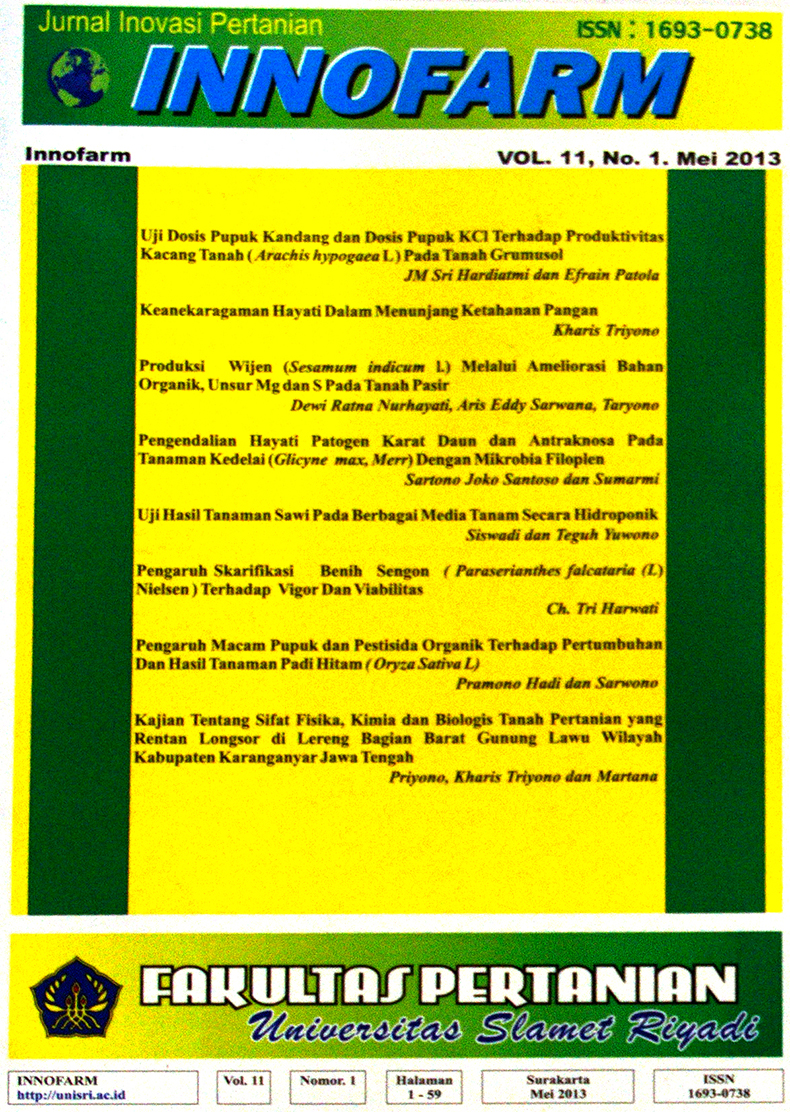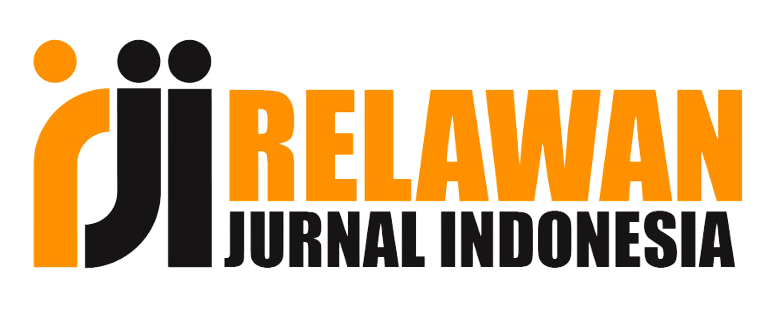Produksi Wijen (Sesamum indicum l.) Melalui Ameliorasi Bahan Organik, Unsur Mg dan S Pada Tanah Pasir
DOI:
https://doi.org/10.33061/innofarm.v11i1.620Abstract
ABSTRAK
Penelitian dengan tujuan menghasilkan paket teknologi aplikatif dalam budidaya wijen melalui ameliorasi bahan organik dan unsur Mg , S telah dilaksanakan di Lahan Pasir pantai Keburuhuan Purworejo, tahun 2012. Lahan pasir dengan produktivitas yang rendah, dicirikan oleh bahan penyusun tanah yang dominan (>80%) terdiri dari pasir sehingga ketersediaan air dan unsur hara tanaman sangat rendah. Untuk itu diperlukan amelioran bahan organik guna perbaikan media tanam dengan pupuk organik. Selain itu diperlukan penambahan unsur Mg dan S, guna meningkatkan kandungan minyak. Rancangan yang digunakan adalah Rancangan Acak Kelompok Lengkap dengan 3 kali ulangan. Dengan dua faktor Macam Bahan Organik dan dosis. Faktor Macam Bahan Organik meliputi : B0 = Kontrol, B1 = Bahan organik dari kotoran ayam, B2 = Bahan organik dari kotoran ternak sapi, B3 = Bahan organik dari sersah daun dan sekam dan jerami. Dosis yang diterapkan meliputi: D0 = Kontrol U1 : Hara Mg 0,2 gr, D1 = 10 ton/ha U2 : Hara S 0,4 gr, D2 = 15 ton/ha, D3 = 20 ton/ha. Dari tiga faktor penelitian tersebut diperoleh 32 variasi perlakuan, adapun varietas yang digunakan adalah : SBR 4. Variabel dan analisis pertumbuhan tanaman meliputi: tinggi tanaman, jumlah bunga, umur berbunga, berat biji per tanaman, jumlah polong per tanaman, jumlah biji per polong, umur panen, dan kadar minyak. Ameliorasi menggunakan pupuk kandang ayam dengan dosis 15 ton /ha, dengan penambahan Mg dan S dalam budidaya wijen di lahan pasir pantai mampu meningkatkan kadar minyak total sebesar 15%.
Â
Key Word : Ameliorasi, Lahan pasir pantai, Bahan organik, varietas wijen.
Production of Sesame (Sesamum indicum l.) by organic amelioration, Mg and SÂ in the Sandy land
ABSTRACT
Research with the goal of producing the package of applied technology in the cultivation of sesame through amelioration of organic matter and the elements Mg, S has been implemented in the sand beach Land Keburuhuan Purworedjo, in 2012. Sandy land with low productivity, characterized by the dominant soil constituent materials (> 80%) composed of sand so that the availability of water and plant nutrients is very low. It required ameliorant organic materials to repair the planting medium with organic fertilizer. Also required the addition of elements Mg and S, in order to increase the oil content. The design used was Completely Randomized Block Design with 3 replications. With two factors Various Organic Materials and dose. Various factors Organic Ingredients include: B0 = Control, B1 = organic material from chicken manure, B2 = Organic matter from cattle dung, B3 = organic material from leaves and chaff and straw. The dose applied include: D0 = control U1: Hara Mg 0.2 g, D1 = 10 tonnes / ha U2: Hara S 0.4 g, D2 = 15 tonnes / ha, D3 = 20 tonnes / ha. Of the three factors the research there were 32 variations of treatment, while the varieties used are: SBR 4. Variables and analysis of plant growth include: plant height, number of flowers, flowering, seed weight per plant, number of pods per plant, number of seeds per pod, harvest, and oil content. Amelioration using chicken manure at a dose of 15 tonnes / ha, with the addition of Mg and S in the cultivation of sesame in beach sand land to increase total oil content of 15%.
Key Word: amelioration, sandy land, organic material, sesame varieties.
Downloads
Published
Issue
Section
License
Authors who publish this journal agree to the following terms:
- Authors retain copyright and grant the journal right of first publication with the work simultaneously licensed under a Creative Commons Attribution License that allows others to share the work with an acknowledgement of the work's authorship and initial publication in this journal.
- Authors can separately make additional contractual arrangements for non-exclusive distribution published by the journal (e.g., publish it in a book), with an acknowledgement of its initial publication in this journal.
- Authors are allowed and encouraged to send their work via online (e.g., in the institutional repositories or their website) after published by the journal.


















